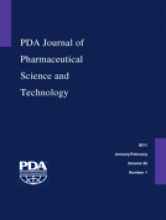Abstract
The Milliflex Rapid System is used as a rapid microbiological method based on adenosine triphosphate (ATP) bioluminescence in the pharmaceutical industry to quantify the amount of micro-organisms present in water and in bioburden samples. The system can also be used for qualitative analyses, for example, to perform a rapid sterility test. This rapid sterility test has been successfully validated and implemented at Novartis and Sandoz. As the reagents used for the ATP bioluminescence reaction, which are directly sprayed on a micro-colony, disrupt the walls/membranes of the present cells to release ATP and therefore no intact cells for subsequent identification were believed to be present, the identification was supposed to be impossible until now.
During development and validation of a rapid sterility test with the Milliflex Rapid System, a possibility to identify contaminants was found. A method based on regrowth of the Milliflex Rapid-treated microbial cells and consecutive genotypic identification reproduced feasible and robust results. The data presented here show that sufficient recovery of the micro-colonies detected with the Milliflex Rapid System was reached with the test strains, except with Penicillium spec. The chosen micro-organisms represent the full spectrum of environmental isolates and ATCC strains, and it was shown that they are not destroyed after application of the reagents for the ATP bioluminescence reaction.
Overall, 22 stressed microbial strains were examined during the study.
LAY ABSTRACT: After Milliflex Rapid System detection, it was supposed that a subsequent identification of the contaminant is not possible. In this paper it is shown how contaminants can be identified in the rapid sterility test application.
- ©PDA, Inc. 2011
PDA members receive access to all articles published in the current year and previous volume year. Institutional subscribers received access to all content. Log in below to receive access to this article if you are either of these.
If you are neither or you are a PDA member trying to access an article outside of your membership license, then you must purchase access to this article (below). If you do not have a username or password for JPST, you will be required to create an account prior to purchasing.
Full issue PDFs are for PDA members only.
Note to pda.org users
The PDA and PDA bookstore websites (www.pda.org and www.pda.org/bookstore) are separate websites from the PDA JPST website. When you first join PDA, your initial UserID and Password are sent to HighWirePress to create your PDA JPST account. Subsequent UserrID and Password changes required at the PDA websites will not pass on to PDA JPST and vice versa. If you forget your PDA JPST UserID and/or Password, you can request help to retrieve UserID and reset Password below.






